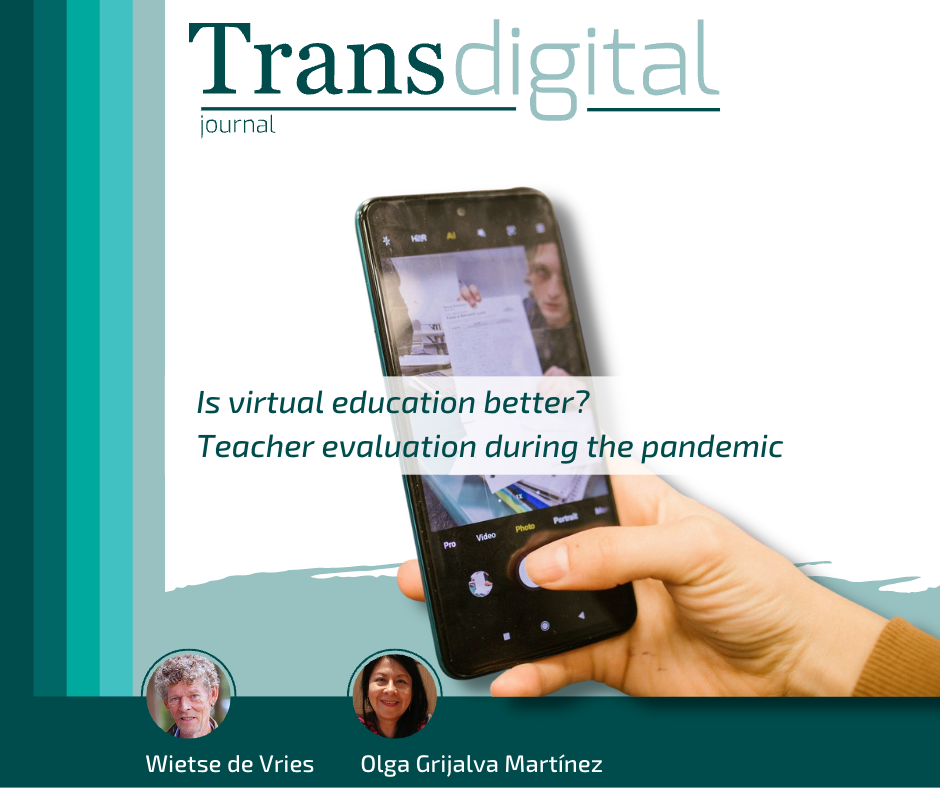Is virtual education better? Teacher evaluation during the pandemic
DOI:
https://doi.org/10.56162/transdigital195Keywords:
virtual education, educational technologies, teacher evaluation, COVID-19 pandemicAbstract
The COVID-19 pandemic radically changed teaching at the Benemérita Universidad Autónoma de Puebla (BUAP) in Mexico. Practically overnight, teachers and students had to move from the classroom to online education. This form of teaching continued until the fall of 2022, when all courses returned to the classroom. The transition generated debates about the pros and contras of virtual education. This paper reviews virtual education from the perspective of teacher evaluation, an assessment of teachers’ performance carried out by students each semester. The period of analysis was from the end of 2019 till the end of 2022, allowing for comparisons before, during, and after the pandemic. The data analysis reveals that, according to students, teachers’ performance improved during the pandemic. However, it also stands out that the transition remained limited to a shift from face-to-face to online presentations, with little use of Learning Management Systems. The data suggest that most courses could continue online or in a hybrid mode. Teachers’ qualifications effectively show a slight decline after returning to the classroom. It raises the question of why everyone seems keen to return to the old normal.
References
Almendingen, K., Morseth, M. S., Gjølstad, E., Brevik, A., & Tørris, C. (2021). Student's experiences with online teaching following COVID-19 lockdown: A mixed methods explorative study. PLoS ONE, 16(8). https://doi.org/10.1371/journal.pone.0250378
BUAP. (2020). Anuario estadístico 2019-2020. Puebla: Benemérrita Universidad Autónoma de Puebla.
Bundsgaard, J., & Hansen, T. I. (2011). Evaluation of learning materials: A holistic framework. Journal of Learning Design, 4, 31-44. http://dx.doi.org/10.5204/jld.v4i4.87
Champagne, E., & Granja, A. D. (2021, April 7). How the COVID-19 pandemic may have changed university teaching and testing for good. Phys.Org. https://es.scribd.com/document/514927214/How-the-COVID-19-pandemic-may-have-changed-university-teaching-and-testing-for-good
Danver, S. L. (2016). The SAGE Encyclopedia of Online Education. SAGE.
de Vries, W., González, G., León, P., & Hernández, I. (2008). Políticas públicas y desempeño académico, o cómo el tamaño sí importa. CPU-e (7), 2-32. https://www.uv.mx/cpue/num7/inves/completos/de_vries_politicas_publicas.pdf
Estévez Nenninger, E. H. (2009). El doctorado no quita lo tarado. ANUIES.
Griffin, T. J., Hilton III, J., Plummer, K., & Barret, D. (2014). Correlation between grade point averages and student evaluation of teaching scores: Taking a closer look. Assessment & Evaluation in Higher Education, 39(3), 339-348.
Kinzie, J., & Kuh, G.D. (2017). Reframing Student Success in College: Advancing Know-What and Know-How. Change: The Magazine of Higher Learning, 49, 19 – 27.
Luna Serrano, E. (2002). La participación de los docentes y los estudiantes en la evaluación de la docencia. Plaza y Valdés/UABC.
Luna Serrano, E., & Arámburo Vizcarra, V. (2013). Variables asociadas a la competencia docente universitaria en la opinión de los estudiantes. Archivos Analíticos de Políticas Educativas, 21(1). http://dx.doi.org/10.14507/epaa.v21n1.2013
Moreno Rosario, P., & de Vries, W. (2015). Examinar la evaluación de la docencia. Un ejercicio imprescindible de investigación institucional. ANUIES.
Moreno, M. (2015). La Educación Superior a Distancia en México. Una propuesta para su análisis histórico. En J. Zubieta, & C. Rama, La Educación a Distancia en México. Una nueva realidad universitaria (pp. 3-16). Universidad Nacional Autónoma de México. https://doi.org/10.13140/RG.2.1.1440.9360
Ozfidan, B., Ismael, H., & Fayez, O. (2021). Student Perspectives of Online Teaching and Learning During the COVID-19 Pandemic. Online Learning, 25(4). http://dx.doi.org/10.24059/olj.v25i4.2523
Palvia, S., Aeron, P., Gupta, P., Mahapatra, D., Parida, R., Rosner, R., & Sindhi, S. (2018). Online Education: Worldwide Status, Challenges, Trends, and Implications. Journal of Global Information Technology Management, 21(4), 233-241. https://doi.org/10.1080/1097198X.2018.1542262
Rama, C. (2018). Políticas, tensiones y tendencias de la educación a distancia y virtual en América Latina. EUCASA.
Ramírez Martinell, A. & Casillas Alvarado, M. A. (2014). Háblame de TIC : Tecnología Digital en la Educación Superior. Brujas.
Rottmann, A., Barreto, D., & Rabidoux, S. (2020). What in the World is a Learning Management System? En D. Barreto, A. Rottmann, & S. Rabidoux, Learning Management Systems: Choosing the Right Path for your Organization. EdTech Books. https://edtechbooks.org/learning_management_systems/introduction
Rueda Beltrán, M. (2008). La evaluación del desempeño docente en la universidad. Revista Electrónica de Investigación Educativa (Especial). http://redie.uabc.mx/NumEsp1/contenido-rueda.html
Rueda Beltrán, M., & Luna Serrano, E. (2008). Introducción: La docencia universitaria y su evaluación. Revista Electrónica de Investigación Educativa (10-especial), 1-5. https://redie.uabc.mx/redie/article/view/195/335
Turnbull, D., Chugh, R., & Luck, J. (2019). Learning Management Systems: An Overview. En A. Tatnall, Encyclopedia of Education and Information Technologies. Springer. https://doi.org/10.1007/978-3-319-60013-0_248-1
UNADM. (2023, 01 24). Universidad Abierta y a Distancia de México. Historia, Misión, Visión y Objetivo. https://www.unadmexico.mx/nosotros/mision-vision-y-objetivos

Downloads
Autor de correspondencia
El autor de correspodencia se identifica con el siguiente símbolo: *Published
How to Cite
License
Copyright (c) 2023 Wietse de Vries, Olga Grijalva Martínez

This work is licensed under a Creative Commons Attribution 4.0 International License.
All articles in Transdigital are licensed under a Creative Commons Attribution 4.0 International License. Authors hold the copyright and retain publishing rights without restrictions.









